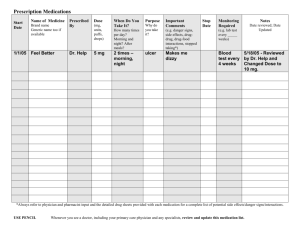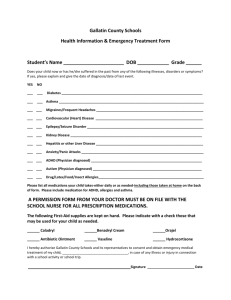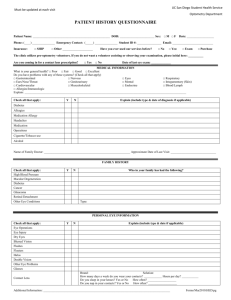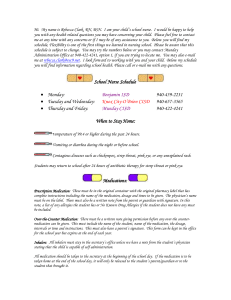Medication Errors (Powerpoint)
advertisement
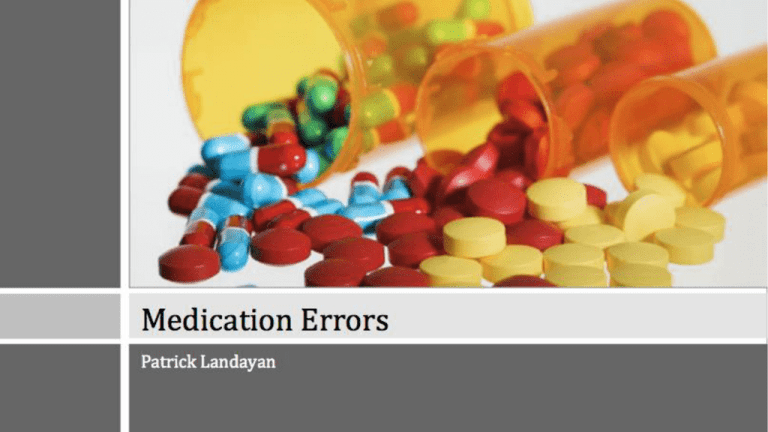
Table of Contents 1) Areas in Which Medication Errors Occur 2) Documenting – Sources of Error a) Allergies – Preventative Actions b) Adverse Reactions - Preventative Actions 3) Prescribing - Sources of Error a) Incorrect Dosage Strength or Route of Administration - Preventative Actions 4) Dispensing - Sources of Error a)Improper Preparation - Preventative Actions b) Dispensing the Wrong Medication - Preventative Actions 5) Reflection 6) Sources Documentin g Areas in Which Medication Errors Occur Prescribing Dispensing Documenting Possible Sources of Error x An allergic reaction to an active or inactive ingredients within the medication x Allergies to certain materials used in preparation process x Adverse drug reactions Allergies – Preventative Actions A patient should keep a complete log of his or her allergies in order to ensure accurate filling of documents while at the doctor’s office or at the hospital. A doctor should leave a note when ordering a medication from the pharmacy in order to ensure the drug is prepared in compliance to the patient’s profile. A pharmacist should place auxiliary labels on all drugs that were made using a latex free method. A nurse should double check the patients record for any allergies before the administration of any drug. Adverse Reactions – Preventative Actions A hospital, pharmacy, or doctor’s office should have a chart identifying all drugs and the drugs they interact with accessible to all. A patient should keep a record of all of the medications they are currently using and medications used in the past to ensure a new drug does not have adverse effects. A hospital should implement a computer system in which the program alerts the doctor of any adverse reactions when placing an order. Prescribing Possible Sources of Error x Incorrect dosage strength could be ordered x Incorrect route of administration could be prescribed Incorrect Dosage Strength or Route of Administration – Preventative Actions A hospital should implement a computer system that requires a double check on drugs that have multiple dosage strength options. A doctor should always make sure to order the quantity that allows the patient to take the least amount of tablets. A doctor, pharmacist, or nurse should review all patient history to assure the patient has no history of problems with a certain route of administration. A patient should familiarize themselves with different routes of administration in order to ensure compliance. • For example, if not comfortable with swallowing pills, a patient should ask the doctor for alternatives. Dispensing Possible Sources of Error x Improper sterile or non-sterile preparation of a drug x The wrong medication, strength, or dosage form dispensed Improper Preparation All staff involved in the preparation of sterile medications should undergo proper training and testing under USP <797> guidelines. All health care providers should implement a “buddy system”. They should check each others work to make sure that the right ingredients are being added, and provide a double check on all calculations and measurements. All staff, when working with drugs that contain ingredients that patients commonly have allergies to (sulfur, penicillin, etc.), should wear gloves. Dispensing the Wrong Medication A Look-Alike Sound-Alike (LASA) chart should be available to all employees and patients in any health care setting. Pharmacists or technicians should place auxiliary labels on bottles or shelves containing medications that are found on the LASA chart. Tall man lettering should be implemented in drugs that show similarity in spelling to other medications. • For example, buPROPion vs. busPIRone. All high-risk drugs should be labeled as such to ensure all staff handling these medications never dispense them accidentally. A drug that comes in different dosage strengths or dosage forms should require a barcode scan when entering or taking out the medication from an automated dispensing machine. Reflection As a co-op student at Beth Israel Deaconess, the main objective of the entire institution was to maintain the highest level of patient care. In the pharmacy department, our way of achieving this goal was to reduce medication errors that could be prevented on our end. This really intrigued me to research this topic because these errors have the potential to cause a lot of harm or could even be fatal. I wanted to put together a presentation that offers recommendations that could be used by any health care professional. I chose a Powerpoint Presentation because allowed me to get the most amount of information in a manner that flowed well. I wanted to separate the information in a way that makes sense, and makes it easy to get to the information you need without sieving through a lot of information. The presentation begins with a table of contents which makes organization clear to the audience. Each slide is also hyperlinked to the table of contents and can be accessed with one click. By choosing a simple and neutral layout and color scheme, my goal was to make it very easy on the eyes. The use of visuals also allows the user to stray from being bored and straining their eyes. I refrained from using visuals on the preventative action slides because I want the audience to be more focused on the text as it is the central idea of my presentation. The information is separated into different parts of patient care process where errors could occur. I then further broke it down into possible sources of error (marked by X’s) in that area and then offered suggestions for these sources (marked with checkmarks). I used color coordination to facilitate organization and keep all the information together. I can see this Powerpoint or separate slides of the presentation hanging up in a pharmacy, doctors office, nurses station. I could also see a nurse, pharmacist, or even a doctor presenting this as a continuing education topic to their peers. Sources FDA and ISMP Lists of Look-Alike Drug Names with Recommended Tall Man Letters. (n.d.). ISMP. Retrieved October 12, 2013, from https://www.ismp.org/tools/tallmanletters.pdf Leach, H. (n.d.). High Risk Medications - Feeling the PINCH!. A Victorian Government Initiative . Retrieved October 11, 2013, from docs.health.vic.gov.au/docs/doc/ 053C11504F0A5A5ECA257A17001EC78D/$FILE/pinch_presentation.pdf Look-alike/sound-alike drug list | Joint Commission. (n.d.). Accreditation, Health Care, Certification | Joint Commission. Retrieved October 13, 2013, from http://www.jointcommission.org/LASA/ Medication Errors Associated with Documented Allergies. (n.d.). Pennsylvania Patient Safety Authority. Retrieved October 12, 2013, from http://patientsafetyauthority.org/ADVISORI Nelson, A., Nguyen, G., & Pham, D. (n.d.). Roundup: Preventing Medication Errors in Health Systems. Pharmacy Times - Practical Information for Today's Pharmacist. Retrieved October 13, 2013, from http://www.pharmacytimes.com/publications/issue/ 2008/2008-07/2008-07-8601 **Note – I believe that this piece will fit perfectly into my professional portfolio. I think that both the visual and textual content are on a professional level which would be a good fit for the portfolio.


